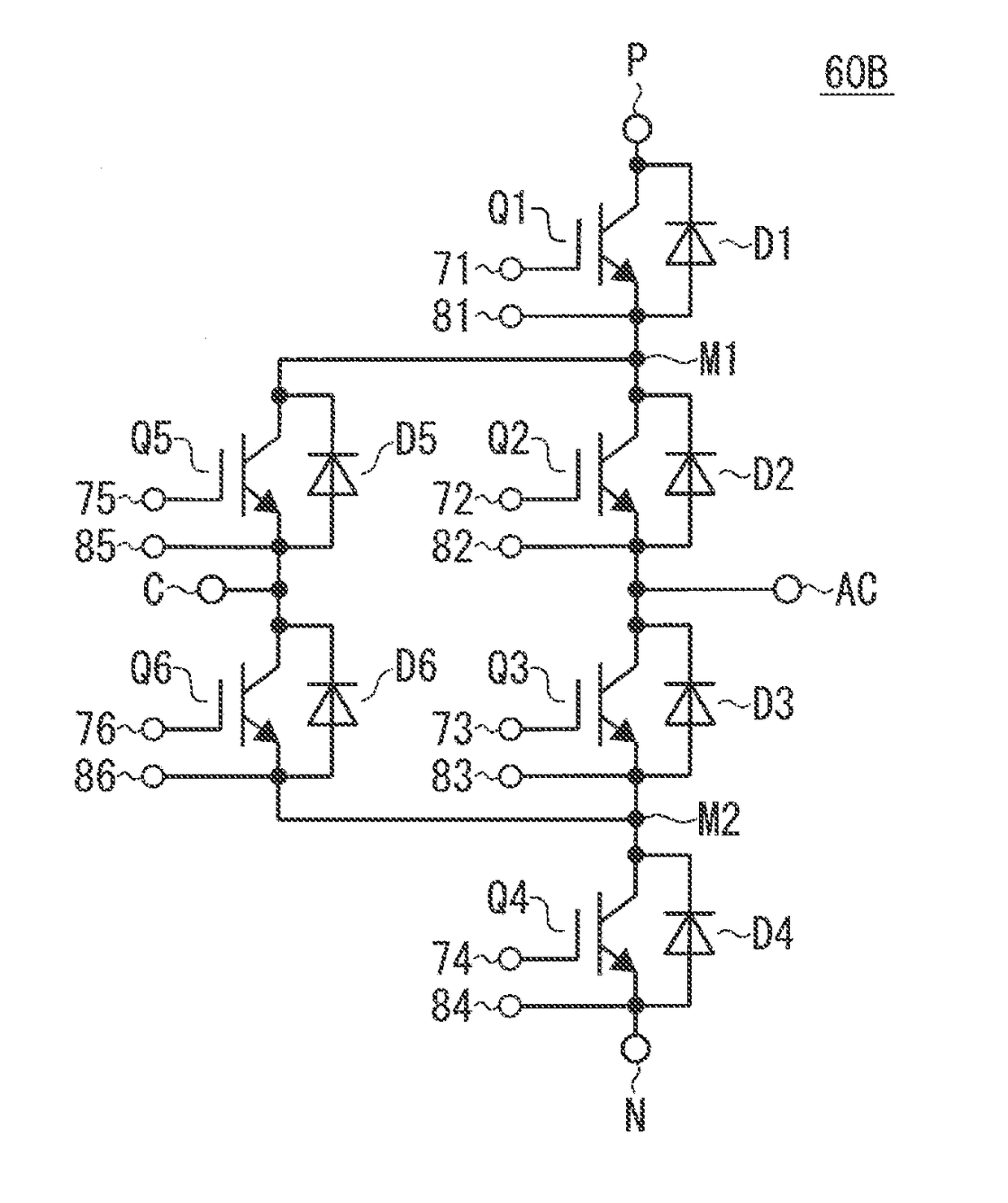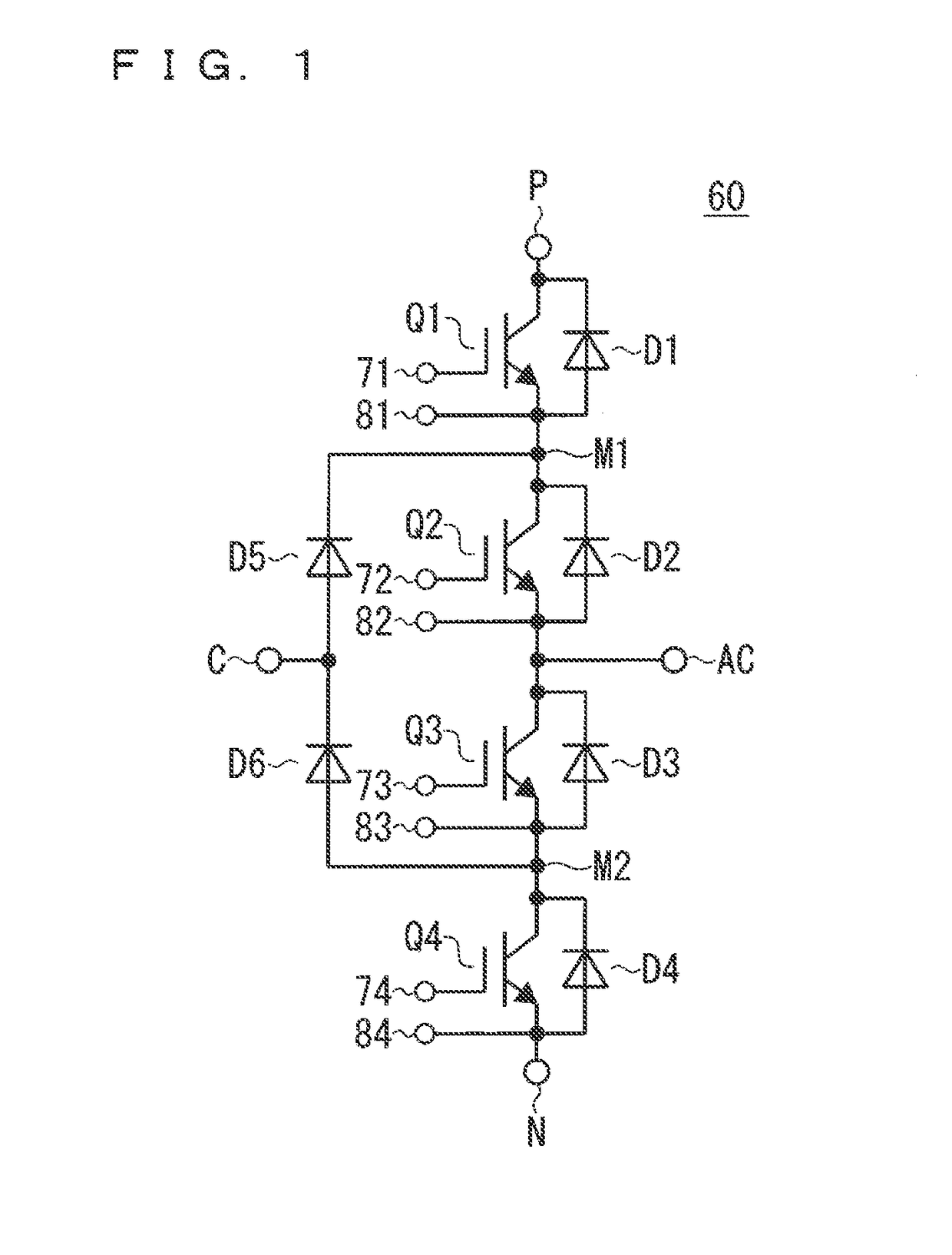Electric-power converting device, solar power conditioner system, electricity storage system, uninterruptible power source system, wind power generation system, and motor drive system
a technology of electric-power conversion and conversion device, which is applied in the direction of electric variable regulation, process and machine control, instruments, etc., can solve the problems of excessive surge voltage generation, circuit inductance, and limited operation range of electric-power conversion device, and achieve effective restraining circuit inductance
- Summary
- Abstract
- Description
- Claims
- Application Information
AI Technical Summary
Benefits of technology
Problems solved by technology
Method used
Image
Examples
first preferred embodiment
[0111](Principles of the Invention)
[0112]FIG. 7 is a circuit diagram showing module allocation substances of the invention of the present application which realizes the inverter circuit 60 shown in FIG. 1 by using the power semiconductor modules 101 to 103 shown inFIG. 3 to FIG. 5.
[0113]As shown in this diagram, the circuit is separated into: a partial circuit part 20A including the transistor Q1, the diode D1, and the diode D5; a partial circuit part 20B including the transistor Q4 and the diodes D4 and D6; and a partial circuit part 20C including the transistors Q2 and Q3 and the diodes D2 and D3; and three power semiconductor modules 101 are allocated for the partial circuit parts 20A to 20C. Hereinafter, the allocation substances will be described in detail.
[0114]Regarding the partial circuit part 20A, the transistor Tr1 of the power semiconductor module 101 or the power semiconductor module 102 is allocated to the transistor Q1, and the diodes Di1 and Di2 are allocated to the d...
second preferred embodiment
[0272]In the above described first preferred embodiment, when the four power semiconductor module devices 100A and the four power semiconductor module devices 100B are mixedly disposed, the 2-column disposition of the module device group 200AB1 and the module device group 200AB2 is employed. A second preferred embodiment employs a configuration in which the four power semiconductor module devices 100A and the four power semiconductor module devices 100B are disposed in a single column.
[0273]FIG. 23 is an explanatory diagram showing a planar configuration of the second preferred embodiment of an electric-power converting device of a case in which the electric-power converting device is realized by a 4-parallel configuration by using the power semiconductor module device 100 shown in FIG. 6.
[0274]A circuit configuration equivalent to the electric-power converting device shown in FIG. 23 is the configuration shown in FIG. 9 as well as the first and second comparative techniques and the...
third preferred embodiment
[0300]FIG. 24 is an explanatory diagram showing an application system, which is a third preferred embodiment. As shown in this diagram, an electric-power converting device 400 is provided in an application system 300. A specific configuration of the electric-power converting device 400 corresponds to the electric-power converting device of the first preferred embodiment shown in FIG. 11 or the electric-power converting device of the second preferred embodiment shown in FIG. 23.
[0301]The application system 300 of the third preferred embodiment has, in the interior thereof, the electric-power converting device 400, thereby exerting the effects of small circuit inductance, a snubber-circuit-less system, downsizing and low cost, low loss, and expansion of operation ranges in relation to the electric-power converting device 400 in the interior.
First Mode
[0302]As a first mode of the application system 300, there is a mode in which a solar power conditioner system is constituted. In the so...
PUM
 Login to View More
Login to View More Abstract
Description
Claims
Application Information
 Login to View More
Login to View More - R&D
- Intellectual Property
- Life Sciences
- Materials
- Tech Scout
- Unparalleled Data Quality
- Higher Quality Content
- 60% Fewer Hallucinations
Browse by: Latest US Patents, China's latest patents, Technical Efficacy Thesaurus, Application Domain, Technology Topic, Popular Technical Reports.
© 2025 PatSnap. All rights reserved.Legal|Privacy policy|Modern Slavery Act Transparency Statement|Sitemap|About US| Contact US: help@patsnap.com



